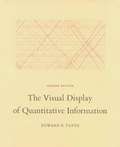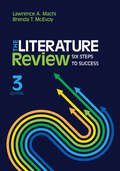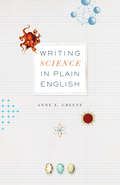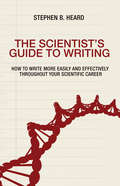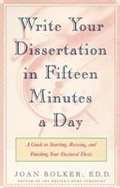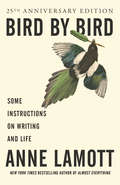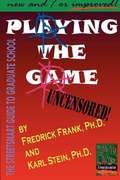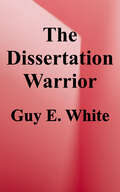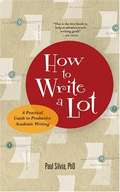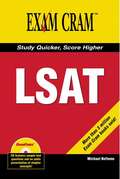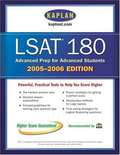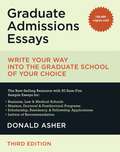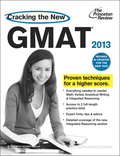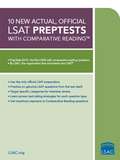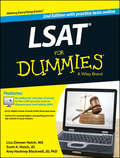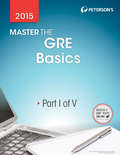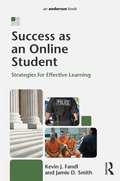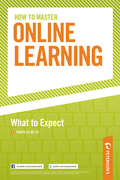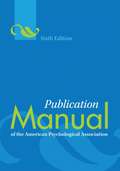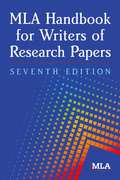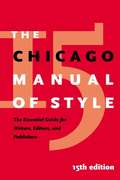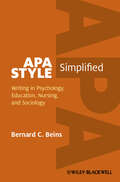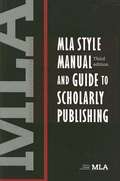Special Collections
Transitioning to Grad School
Description: Are you or is someone you know making the major transition to graduate school? These titles will help make that leap a little bit easier! #gradschool #backtoschool #graduateschool
- Table View
- List View
The Visual Display of Quantitative Information
by Edward TufteThe classic book on statistical graphics, charts, tables. Theory and practice in the design of data graphics, 250 illustrations of the best (and a few of the worst) statistical graphics, with detailed analysis of how to display data for precise, effective, quick analysis. Design of the high-resolution displays, small multiples. Editing and improving graphics. The data-ink ratio. Time-series, relational graphics, data maps, multivariate designs. Detection of graphical deception: design variation vs. data variation. Sources of deception. Aesthetics and data graphical displays. This is the second edition of The Visual Display of Quantitative Information. Recently published, this new edition provides excellent color reproductions of the many graphics of William Playfair, adds color to other images, and includes all the changes and corrections accumulated during 17 printings of the first edition.
The Literature Review
by Dr Lawrence A. Machi and Brenda T. McEvoyFrom daunting to doable in six steps The process of literature search and composing a formal literature review can be intimidating. But masters and doctoral candidates in Education and related fields have found academic argumentation to be seamlessly intuitive with the six-step process pioneered by this book. This updated third edition features a wealth of all-new content including: A flowchart that graphically illustrates Machi and McEvoy’s process. Reflective Oversight boxes in each chapter, prompting readers to direct metacognitive activities. Links to online guides and resources. Expanded examples illustrating theoretical concepts.
Writing Science
by Joshua SchimelAs a scientist, you are a professional writer: your career is built on successful proposals and papers. Success isn't defined by getting papers into print, but by getting them into the reader's consciousness. Writing Science is built upon the idea that successful science writing tells a story. It uses that insight to discuss how to write more effectively. Integrating lessons from other genres of writing with those from the author's years of experience as author, reviewer, and editor, the book shows scientists and students how to present their research in a way that is clear and that will maximize reader comprehension. The book takes an integrated approach, using the principles of story structure to discuss every aspect of successful science writing, from the overall structure of a paper or proposal to individual sections, paragraphs, sentences, and words. It begins by building core arguments, analyzing why some stories are engaging and memorable while others are quickly forgotten, and proceeds to the elements of story structure, showing how the structures scientists and researchers use in papers and proposals fit into classical models. The book targets the internal structure of a paper, explaining how to write clear and professional sections, paragraphs, and sentences in a way that is clear and compelling. The ideas within a paper should flow seamlessly, drawing readers along. The final section of the book deals with special challenges, such as how to discuss research limitations and how to write for the public.
Writing Science in Plain English
by Anne E. GreeneScientific writing is often dry, wordy, and difficult to understand. But, as Anne E. Greene shows in Writing Science in Plain English,writers from all scientific disciplines can learn to produce clear, concise prose by mastering just a few simple principles. This short, focused guide presents a dozen such principles based on what readers need in order to understand complex information, including concrete subjects, strong verbs, consistent terms, and organized paragraphs. The author, a biologist and an experienced teacher of scientific writing, illustrates each principle with real-life examples of both good and bad writing and shows how to revise bad writing to make it clearer and more concise. She ends each chapter with practice exercises so that readers can come away with new writing skills after just one sitting. Writing Science in Plain English can help writers at all levels of their academic and professional careers--undergraduate students working on research reports, established scientists writing articles and grant proposals, or agency employees working to follow the Plain Writing Act. This essential resource is the perfect companion for all who seek to write science effectively.
The Scientist's Guide to Writing
by Stephen B. HeardThe ability to write clearly is critical to any scientific career. The Scientist's Guide to Writing provides practical advice to help scientists become more effective writers so that their ideas have the greatest possible impact.Drawing on his own experience as a scientist, graduate adviser, and editor, Stephen Heard emphasizes that the goal of all scientific writing should be absolute clarity; that good writing takes deliberate practice; and that what many scientists need are not long lists of prescriptive rules but rather direct engagement with their behaviors and attitudes when they write. He combines advice on such topics as how to generate and maintain writing momentum with practical tips on structuring a scientific paper, revising a first draft, handling citations, responding to peer reviews, managing coauthorships, and more.In an accessible, informal tone, The Scientist's Guide to Writing explains essential techniques that students, postdoctoral researchers, and early-career scientists need to write more clearly, efficiently, and easily.Emphasizes writing as a process, not just a productEncourages habits that improve motivation and productivityExplains the structure of the scientific paper and the function of each partProvides detailed guidance on submission, review, revision, and publicationAddresses issues related to coauthorship, English as a second language, and more
Writing Your Dissertation in Fifteen Minutes a Day
by Joan BolkerUsing positive reinforcement, she begins by reminding thesis writers that being able to devote themselves to a project that truly interests them can be a pleasurable adventure. She encourages them to pay close attention to their writing method in order to discover their individual work strategies that promote productivity; to stop feeling fearful that they may disappoint their advisors or family members; and to tailor their theses to their own writing style and personality needs.
Bird by Bird
by Anne LamottNEW YORK TIMES BESTSELLER • An essential volume for generations of writers young and old. The twenty-fifth anniversary edition of this modern classic will continue to spark creative minds for years to come. Anne Lamott is "a warm, generous, and hilarious guide through the writer&’s world and its treacherous swamps" (Los Angeles Times). &“Superb writing advice…. Hilarious, helpful, and provocative.&” —The New York Times Book ReviewFor a quarter century, more than a million readers—scribes and scribblers of all ages and abilities—have been inspired by Anne Lamott&’s hilarious, big-hearted, homespun advice. Advice that begins with the simple words of wisdom passed down from Anne&’s father—also a writer—in the iconic passage that gives the book its title:&“Thirty years ago my older brother, who was ten years old at the time, was trying to get a report on birds written that he&’d had three months to write. It was due the next day. We were out at our family cabin in Bolinas, and he was at the kitchen table close to tears, surrounded by binder paper and pencils and unopened books on birds, immobilized by the hugeness of the task ahead. Then my father sat down beside him, put his arm around my brother&’s shoulder, and said, &‘Bird by bird, buddy. Just take it bird by bird.&’&”
Students with Learning Disabilities at Graduate and Professional School
by Stanley J. AntonoffThis comprehensive text examines strategies to help students with learning and attentional disabilities get the most out of their graduate school experience.
The Dissertation Warrior
by Guy E. WhiteThis book is for the doctoral student who wants to become the best version of himself or herself; whose doctoral journey is a quest of epic personal, professional, and spiritual transformation; and who wants to finish his or her dissertation as well.
Inside this book, you’ll learn, among many other things:
-The secrets of time travel;
-That 99% of that which gets your focus is not worth your time;
-That “writing” your dissertation is the last thing that you should do; and
-How to conquer your introduction, create alignment, build the best darned literature review you possibly can, find and collect your data, and connect all the clues better than a hat-wearing movie archeologist …all while becoming a better spouse, sibling, child of your parents, and man (or woman) of all seasons.
This book is written by me, Dr. Guy. I teach, at the time of writing this book, the world’s most comprehensive online step-by-step dissertation writing course. Through my online training videos, The Dissertation Mentor® Accelerator Program, The Dissertation Mentor® Home Study Course, and The Dissertation Mentor® One-To-One Mentorship, I have helped thousands of doctoral students make progress in their dissertations. I can probably help you too! This book is my manifesto about all things “doctoral.”
How to Write a Lot
by Paul J. SilviaAll students and professors need to write, and many struggle to finish their stalled dissertations, journal articles, book chapters, or grant proposals. Writing is hard work and can be difficult to wedge into a frenetic academic schedule. In this practical, light-hearted, and encouraging book, Paul Silvia explains that writing productively does not require innate skills or special traits but specific tactics and actions. Drawing examples from his own field of psychology, he shows readers how to overcome motivational roadblocks and become prolific without sacrificing evenings, weekends, and vacations. After describing strategies for writing productively, the author gives detailed advice from the trenches on how to write, submit, revise, and resubmit articles, how to improve writing quality, and how to write and publish academic work.
LSAT 180
by Eric GoodmanThe challenging practice and proven strategies you need to get a perfect score on the LSAT. This advanced guide includes: the toughest questions, the most effective logic games tactics, powerful reading comprehension strategies, top scoring logical reasoning techniques
Graduate Admissions Essays
by Donald AsherVeteran higher-education consultant Donald Asher demystifies the graduate school application process and offers a detailed action plan that has proved successful for some of the most competitive programs in the country. The 50 sample essays-selected from thousands of candidates-showcase the best of the best, while the Essay Hall of Shame identifies common pitfalls to avoid. Sample letters of recommendation and essays for scholarships, residencies, fellowships, and postgraduate and postdoctoral applications cover all stages of the application process. Teaches how to craft a winning essay with 50 state-of-the-art samples to inspire, instruct, and all but guarantee a top-of-the-pile application. Updated third edition includes an entirely new chapter dedicated to online applications and how they're managed, processed, and considered. Previous editions have sold 100,000 copies.
Cracking the New GMAT, 2013 Edition
by Princeton ReviewIf you need to know it for the next-generation GMAT, it's in this book. Cracking the New GMAT, 2013 Edition has been completely revised and updated for the June 2012 changes to the GMAT. This ebook edition has had all questions, answers, and explanations cross-linked for easy on-screen viewing, and includes: * Access to 2 full-length practice tests * Tons of sample problems and drills in the book covering all 4 GMAT sections, plus more extra practice on the companion web site * Step-by-step instruction on the new GMAT question types: table analysis, graphics interpretation, multi-source reasoning, and two-part analysis * Thorough review of all tested topics, including data sufficiency, arithmetic, algebra, geometry, sentence correction, reading comprehension, critical reasoning, and more
New Actual, Official LSAT Preptests with Comparative Reading
by Law School Admission CouncilThis essential LSAT preparation tool encompasses PrepTest 52 (the September 2007 LSAT) through PrepTest 61 (the October 2010 LSAT).
LSAT For Dummies
by Zimmer Hatch and Scott Hatch and Amy Hackney BlackwellA detailed study guide that guarantees a high LSAT scoreIf you thought you left standardized tests back in high school, think again. LSAT For Dummies, 2rd Edition is an all-inclusive study guide arming you with tips and know-how for your next career move. This updated edition includes three full-length practice tests, a review of foundational concepts for every section, thorough explanations, and additional practice problems for all question types. Whether you're taking the LSAT for the first time or the third time, this book will provide the guidance and skill set you need to obtain a score that reflects your abilities. Instead of facing the process alone, turn to the trusted For Dummies brand for proven test-taking strategies and ample practice opportunities.Ideal for those who want to break into this increasingly competitive field, in which a high score on the LSAT lends prospective lawyers an undeniable advantageExamines every topic and common pitfalls covered in the test, which consists of five 35-minutes sections of multiple-choice questions and a 35-minute writing sampleFor aspiring law school students, LSAT For Dummies is the most advantageous guide to increasing your score on a test that can make or break your legal aspirations.
Master the GRE 2015
by Peterson'sPeterson's Master the GRE® 2015: Basics offers a thorough introduction to the revised GRE. It discusses the test organization and time limits, explains how the test is administered, and addresses how the test is scored. You will find a detailed explanation of what to expect on test day and which procedures and regulations to follow. Also offered is general test-taking strategies to help you score high on the exam and a review of each section and question type you will encounter when taking the GRE. Special attention is given to international students, who will take the paper-and-pencil version of the GRE. This eBook is a breakout section containing selected content from Peterson's Master the GRE 2015. For further GRE test preparation, the complete eBook and other breakout sections are also available.
Success as an Online Student
by Kevin J. Fandl and Jamie D. SmithThis book presents concise guidance to make the online learning journey enjoyable, productive, and most of all, worthwhile.
How to Master Online Learning
by Peterson'sTakes the reader through the process of taking a course online. Peterson's guide provides a sample syllabus, offers suggestions for how to pay for courses, and also gives tips on making the most of the online learning experience. Selling Points: 1. Answers to the questions: What is online learning? What types of online education are available? Who are online learners? 2. Chapters covering online learning experiences, online study habitats, live chat sessions, and working in virtual groups 3. Truths and myths of online learning and common mistakes online learners make 4. Information about online degree programs, online certifications, and continuing education 5. Advice on paying for online learning, classes, software, and textbooks 6. Guidance on plagiarism and citing references correctly
Publication Manual of the American Psychological Association (6th Edition)
by American Psychological AssociationThe style manual of choice for writers, editors, students, and educators in the social and behavioral sciences, this updated "Publication Manual" provides invaluable guidance on all aspects of the writing process, from the ethics of authorship to the word choice that best reduces bias.
MLA Handbook for Writers of Research Papers (7th edition)
by Joseph GibaldiThe seventh edition of the MLA Handbook is a comprehensive, up-to-date guide to research and writing in the online environment. It provides an authoritative update of MLA documentation style.
The Chicago Manual of Style (15th Edition)
by University of Chicago PressIn the 1890s, a proofreader at the University of Chicago Press prepared a single sheet of typographic fundamentals intended as a guide for the University community. That sheet grew into a pamphlet, and the pamphlet grew into a book--the first edition of the Manual of Style, published in 1906. Now in its fifteenth edition,The Chicago Manual of Style--the essential reference for authors, editors, proofreaders, indexers, copywriters, designers, and publishers in any field--is more comprehensive and easier to use than ever before. Those who work with words know how dramatically publishing has changed in the past decade, with technology now informing and influencing every stage of the writing and publishing process. In creating the fifteenth edition of the Manual, Chicago's renowned editorial staff drew on direct experience of these changes, as well as on the recommendations of the Manual's first advisory board, composed of a distinguished group of scholars, authors, and professionals from a wide range of publishing and business environments. Every aspect of coverage has been examined and brought up to date--from publishing formats to editorial style and method, from documentation of electronic sources to book design and production, and everything in between. In addition to books, the Manual now also treats journals and electronic publications. All chapters are written for the electronic age, with advice on how to prepare and edit manuscripts online, handle copyright and permissions issues raised by technology, use new methods of preparing mathematical copy, and cite electronic and online sources. A new chapter covers American English grammar and usage, outlining the grammatical structure of English, showing how to put words and phrases together to achieve clarity, and identifying common errors. The two chapters on documentation have been reorganized and updated: the first now describes the two main systems preferred by Chicago, and the second discusses specific elements and subject matter, with examples of both systems. Coverage of design and manufacturing has been streamlined to reflect what writers and editors need to know about current procedures. And, to make it easier to search for information, each numbered paragraph throughout the Manual is now introduced by a descriptive heading. Clear, concise, and replete with commonsense advice,The Chicago Manual of Style, fifteenth edition, offers the wisdom of a hundred years of editorial practice while including a wealth of new topics and updated perspectives. For anyone who works with words, whether on a page or computer screen, this continues to be the one reference book you simply must have. What's new in the Fifteenth Edition: * Updated material throughout to reflect current style, technology, and professional practice * Scope expanded to include journals and electronic publications * Comprehensive new chapter on American English grammar and usage by Bryan A. Garner (author of A Dictionary of Modern American Usage) * Updated and rewritten chapter on preparing mathematical copy * Reorganized and updated chapters on documentation, including guidance on citing electronic sources * Streamlined coverage of current design and production processes, with a glossary of key terms * Descriptive headings on all numbered paragraphs for ease of reference * New diagrams of the editing and production processes for both books and journals, keyed to chapter discussions * New, expanded Web site with special tools and features for Manual users at www.chicagomanualofstyle.org
APA Style Simplified
by Bernard C. BeinsThis is a compact but comprehensive guide to writing clearly and effectively in APA style.Demonstrates how to write objective scientific research papers using interesting proseIncorporates guidelines from the 6th edition of the APA publication manualExplores how to develop ideas, connect them to what others have written, and express them clearlyDiscusses the differences between written, oral, and poster presentations and offers instructions for applying APA style to each
MLA Style Manual and Guide to Scholarly Publishing (3rd Edition)
by The Modern Language Association of AmericaA complete, up-to-date guide for writing scholarly texts, documenting research sources, submitting manuscripts to publishers, and dealing with legal issues surrounding publication.
